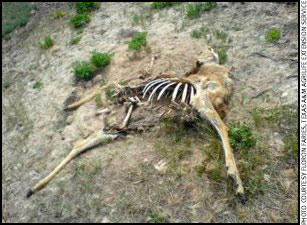Anthrax Case Confirmed in Texas
Confirmed anthrax case rekindles need for awareness
of indigenous disease.
A recent case of anthrax in a cow southwest of San Angelo confirmed by the Texas Animal Health Commission (TAHC) should serve as a reminder to those in areas with a history of the disease to vaccinate their animals, said a Texas A&M AgriLife Extension Service official.

Josh Blanek, AgriLife Extension agent for agriculture and natural resources in Tom Green County, said instances of livestock and deer losses to anthrax — though rare — are certainly not unheard of in the region.
“Anthrax is an ancient disease caused by spore-forming bacteria, Bacillus anthracis, that most often occur in low-lying areas following drought and then subsequent rains, which can expose the spores in the soil to grazing animals,” Blanek said. “Non-vaccinated livestock and deer can become infected by ingesting, and on rare occasions, by inhaling the anthrax spores in the soil and on vegetation while grazing contaminated areas. Such cases are invariably fatal.
“There is usually a history of previous outbreaks in the area, but since years may go by between outbreaks, new landowners or lessees may be unaware of the danger.”
Floron “Buddy” Faries, AgriLife Extension state veterinarian at College Station, said rainwater erosion concentrates anthrax spores in the soil in localized areas called “hot spots” in contaminated pastures. Active, infectious spores surface from the soil under dry, dusty conditions. Surface water from fall rains will relocate the spores in the dusty soil and create additional hot spots. Exposure occurs when an animal happens to graze the vegetation in the hot spot. This restricted exposure to spores limits the number of deaths on the contaminated pasture.
Faries said an inexpensive annual vaccine is readily available specifically for livestock and horses; however, to be effective, it must be given before the animal is exposed to the bacteria. Anthrax vaccine is produced by Colorado Serum Co. A distributor guide and online purchase are available at www.colorado-serum.com. The sale price of the vaccine for a 50-dose bottle is about $50, or about $1 per dose. Most producers in known anthrax areas routinely vaccinate in early spring.
“Fall and winter seasons are not correct timing of anthrax vaccination,” Faries said. “Immunity is protective after a few weeks following vaccination. Protective immunity reduces after several months, so annual boosters are necessary. Since anthrax is a summer disease, the correct timing of vaccination is during the spring so animals have protective immunity during the summer season.”
Infected animals usually show symptoms within three to seven days and die within two days once symptoms occur, Blanek said. Deer or livestock that show signs of staggering, difficulty breathing, trembling or fever and suddenly die should be left alone and a veterinarian called as soon as possible.
“People become exposed to anthrax through handling an infected dead or sick animal,” Blanek said. “The carcass of an animal killed by anthrax usually shows little or no rigor mortis or the stiffness that occurs soon after death. Dark nonclotting blood usually oozes from the mouth, nose and anus, and the body quickly bloats and decomposes rapidly.
“Never cut into a suspect animal, because if it actually does have the disease, doing so will release the anthrax spores into the environment, exposing you and the surrounding area to the disease. Hunters, do not process a suspect deer for meat, and given the graphic symptoms of the disease and the possibility of infection to you, I have no idea why you would.”
Faries said hunters can be exposed to anthrax by handling antlers and bones of even decayed deer that died of anthrax.
“Shed antlers are safe to collect, since the antlers are shed from healthy bucks, not infected with anthrax,” Faries said. “The risk comes from antlers from carcasses of bucks that died of anthrax, in which case the antlers are still attached to the skull and are not sheds.”
Blanek noted that anthrax tends to go dormant in cooler weather, which coincides with Texas’ traditional deer season, so exposure is significantly less likely, though possible. He said the proper handling of deer by only harvesting healthy animals, wearing latex gloves and long-sleeved shirts when field-dressing the animals, and thoroughly cooking the meat before eating it should preclude possible problems.
Faries said TAHC regulations require owners and/or caretakers of animals that died of anthrax to burn each carcass until they are thoroughly consumed to prevent further contamination of the soil with the organism. Burning carcasses is the only method to ensure that the anthrax bacteria will be killed. They strongly advise wearing a mask and gloves when handling sick or dead animals.
For more information on anthrax see the following:
http://www.tahc.state.tx.us/animal_health/anthrax/anthrax.html
http://www.tahc.state.tx.us/news/brochures/TAHCBrochure_Anthrax.pdf
http://www.tahc.state.tx.us/news/brochures/TAHCBrochure_Anthrax-SPANISH.pdf
http://aces.nmsu.edu/pubs/_b/b-120.pdf






